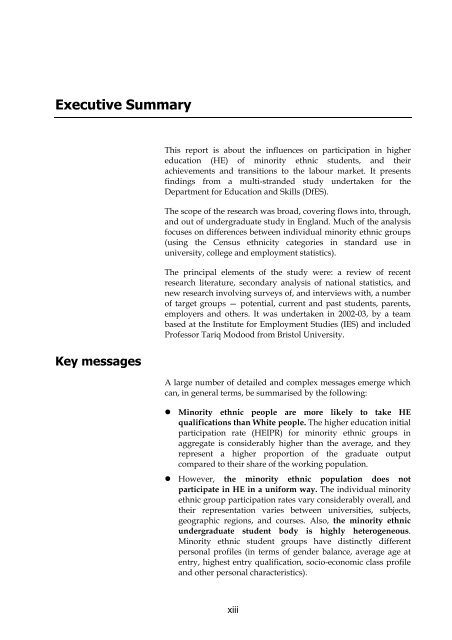A Closer Look at Higher Education Minority Ethnic Students and ...
A Closer Look at Higher Education Minority Ethnic Students and ...
A Closer Look at Higher Education Minority Ethnic Students and ...
You also want an ePaper? Increase the reach of your titles
YUMPU automatically turns print PDFs into web optimized ePapers that Google loves.
Executive SummaryThis report is about the influences on particip<strong>at</strong>ion in highereduc<strong>at</strong>ion (HE) of minority ethnic students, <strong>and</strong> theirachievements <strong>and</strong> transitions to the labour market. It presentsfindings from a multi-str<strong>and</strong>ed study undertaken for theDepartment for Educ<strong>at</strong>ion <strong>and</strong> Skills (DfES).The scope of the research was broad, covering flows into, through,<strong>and</strong> out of undergradu<strong>at</strong>e study in Engl<strong>and</strong>. Much of the analysisfocuses on differences between individual minority ethnic groups(using the Census ethnicity c<strong>at</strong>egories in st<strong>and</strong>ard use inuniversity, college <strong>and</strong> employment st<strong>at</strong>istics).The principal elements of the study were: a review of recentresearch liter<strong>at</strong>ure, secondary analysis of n<strong>at</strong>ional st<strong>at</strong>istics, <strong>and</strong>new research involving surveys of, <strong>and</strong> interviews with, a numberof target groups — potential, current <strong>and</strong> past students, parents,employers <strong>and</strong> others. It was undertaken in 2002-03, by a teambased <strong>at</strong> the Institute for Employment Studies (IES) <strong>and</strong> includedProfessor Tariq Modood from Bristol University.Key messagesA large number of detailed <strong>and</strong> complex messages emerge whichcan, in general terms, be summarised by the following:• <strong>Minority</strong> ethnic people are more likely to take HEqualific<strong>at</strong>ions than White people. The higher educ<strong>at</strong>ion initialparticip<strong>at</strong>ion r<strong>at</strong>e (HEIPR) for minority ethnic groups inaggreg<strong>at</strong>e is considerably higher than the average, <strong>and</strong> theyrepresent a higher proportion of the gradu<strong>at</strong>e outputcompared to their share of the working popul<strong>at</strong>ion.• However, the minority ethnic popul<strong>at</strong>ion does notparticip<strong>at</strong>e in HE in a uniform way. The individual minorityethnic group particip<strong>at</strong>ion r<strong>at</strong>es vary considerably overall, <strong>and</strong>their represent<strong>at</strong>ion varies between universities, subjects,geographic regions, <strong>and</strong> courses. Also, the minority ethnicundergradu<strong>at</strong>e student body is highly heterogeneous.<strong>Minority</strong> ethnic student groups have distinctly differentpersonal profiles (in terms of gender balance, average age <strong>at</strong>entry, highest entry qualific<strong>at</strong>ion, socio-economic class profile<strong>and</strong> other personal characteristics).xiii
















